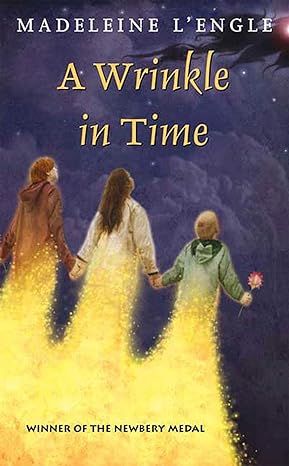A Wrinkle in Time: (Newbery Medal Winner) (A Wrinkle in Time Quintet, 1)Hardcover
4.4
-
27,579 ratings
NEWBERY MEDAL WINNER • TIME MAGAZINE’S 100 BEST FANTASY BOOKS OF ALL TIME • NOW A MAJOR MOTION PICTURE FROM DISNEY
Read the ground-breaking science fiction and fantasy classic that has delighted children for over 60 years!
"A Wrinkle in Time is one of my favorite books of all time. I've read it so often, I know it by heart." ―Meg Cabot
Late one night, three otherworldly creatures appear and sweep Meg Murry, her brother Charles Wallace, and their friend Calvin O'Keefe away on a mission to save Mr. Murray, who has gone missing while doing top-secret work for the government. They travel via tesseract--a wrinkle that transports one across space and time--to the planet Camazotz, where Mr. Murray is being held captive. There they discover a dark force that threatens not only Mr. Murray but the safety of the whole universe.
A Wrinkle in Time is the first book in Madeleine L’Engle’s Time Quintet.
The novel offers a glimpse into the war between light and darkness, and good and evil, as the young characters mature into adolescents on their journey. The novel wrestles with questions of spirituality and purpose, as the characters are often thrown into conflicts of love, divinity, and goodness. It is the first book in L'Engle's Time Quintet, which follows the Murry family and O'Keefe.
L'Engle modeled the Murry family on her own. B.E. Cullinan noted that L'Engle created characters who "share common joy with a mixed fantasy and science fiction setting". The novel's scientific and religious undertones are therefore highly reflective of the life of L'Engle.
The book has inspired a 2003 television film directed by John Kent Harrison, and a 2018 theatrical film directed by Ava DuVernay, both produced by The Walt Disney Company.
Read more
Kindle
$7.99
Available instantly
Audiobook
$0.00
with membership trial
Hardcover
$14.91
Mass Market Paperback
$7.34
Ships from
Amazon.com
Payment
Secure transaction
ISBN-10
0312367554
ISBN-13
978-0312367558
Print length
224 pages
Language
English
Publisher
Square Fish
Publication date
April 30, 2007
Dimensions
4.15 x 0.65 x 6.7 inches
Item weight
3.95 ounces
Popular highlights in this book
But of course we can’t take any credit for our talents. It’s how we use them that counts.
Highlighted by 6,144 Kindle readers
We look not at the things which are what you would call seen, but at the things which are not seen. For the things which are seen are temporal. But the things which are not seen are eternal.
Highlighted by 5,650 Kindle readers
Product details
ASIN :
B004OA64H0
File size :
1148 KB
Text-to-speech :
Enabled
Screen reader :
Supported
Enhanced typesetting :
Enabled
X-Ray :
Enabled
Word wise :
Enabled
Editorial reviews
“A Wrinkle in Time is one of my favorite books of all time. I've read it so often, I know it by heart. Meg Murry was my hero growing up. I wanted glasses and braces and my parents to stick me in an attic bedroom. And I so wanted to save Charles Wallace from IT.” ―Meg Cabot
“A book that every young person should read, a book that provides a road map for seeking knowledge and compassion even at the worst of times, a book to make the world a better place.” ―Cory Doctorow
“An exhilarating experience.” ―Kirkus Reviews
“This imaginative book will be read for a long time into the future.” ―Children's Literature
Sample
Chapter One
"Now, don't be frightened, loves," Mrs. Whatsit said. Her plump little body began to shimmer, to quiver, to shift. The wild colors of her clothes became muted, whitened. The pudding-bag shape stretched, lengthened, merged. And suddenly before the children was a creature more beautiful than any Meg had even imagined, and the beauty lay in far more than the outward description. Outwardly Mrs. Whatsit was surely no longer a Mrs. Whatsit. She was a marble-white body with powerful flanks, something like a horse but at the same time completely unlike a horse, for from the magnificently modeled back sprang a nobly formed torso, arms, and a head resembling a man's, but a man with a perfection of dignity and virtue, an exaltation of joy such as Meg had never before seen. No, she thought, it's not like a Greek centaur. Not in the least.
From the shoulders slowly a pair of wings unfolded, wings made of rainbows, of light upon water, of poetry.
Calvin fell to his knees.
"No," Mrs. Whatsit said, though her voice was not Mrs. Whatsit's voice. "Not to me, Calvin. Never to me. Stand up."
"Ccarrry themm," Mrs. Which commanded.
With a gesture both delicate and strong Mrs. Whatsit knelt in front of the children, stretching her wings wide and holding them steady, but quivering. "Onto my back, now," the new voice said.
The children took hesitant steps toward the beautiful creature.
Read more
About the authors
Madeleine L'Engle
Madeleine was born on November 29th, 1918, and spent her formative years in New York City. Instead of her school work, she found that she would much rather be writing stories, poems and journals for herself, which was reflected in her grades (not the best). However, she was not discouraged.
At age 12, she moved to the French Alps with her parents and went to an English boarding school where, thankfully, her passion for writing continued to grow. She flourished during her high school years back in the United States at Ashley Hall in Charleston, South Carolina, vacationing with her mother in a rambling old beach cottage on a beautiful stretch of Florida Beach.
She went to Smith College and studied English with some wonderful teachers as she read the classics and continued her own creative writing. She graduated with honors and moved into a Greenwich Village apartment in New York. She worked in the theater, where Equity union pay and a flexible schedule afforded her the time to write! She published her first two novels during these years—A Small Rain and Ilsa—before meeting Hugh Franklin, her future husband, when she was an understudy in Anton Chekov’s The Cherry Orchard. They married during The Joyous Season.
Read more
Reviews
Customer reviews
4.4 out of 5
27,579 global ratings
MereChristian
5
Fascinating Mix of Myth, Fantasy, and Science Fiction
Reviewed in the United States on October 13, 2017
Verified Purchase
A Wrinkle of Time is a sci-fi fantasy novel by Madeleine L'Engle. The story is in many respects similar to the type of fiction that one would expect of CS Lewis' The Chronicles of Narnia, in that much religious mythology and symbolism are used. In some ways, this is more blatant, and in other ways, less blatant, than the Narnia books.
The story is about a teenage girl named Meg Murry, whose father has been missing for several years. Originally on a research mission for the US government, the brilliant scientist (both Meg's parents are brilliant scientists) vanished. While the government says that he is "serving his country", the family is worried, and most of the small town where they live has assumed the worst. Despite their worry, the family insists that the father is coming back someday.
This seems to be a point of contention between the Murrys and the rest of the town. The rest of the town wants the Murrys to see the truth, as they think it is, and they also are put off by the Meg and her behavior. You see, while all of the Murry children are quite brilliant, Meg and her youngest brother Charles Wallace, are brilliant but troubled in that their quirkiness gets them weird reactions from folks.
Into this situation come three strange older women, who look like typical, though extremely eccentric in their own right, senior citizens. But they are not. They know things no one else should. Things about the Murry family, Dr. Murry's (the vanished husband) research, and about everyone in general.
These three women, Mrs. Whatsit, Mrs. Which, and Mrs. Who, take Meg, Charles Wallace, and their new friend Calvin, on a trip through realms of magic and science to another world, one where there father is trapped and held captive by an insidiously evil force. This force has turned many planets toward it's ends, and while it didn't seek out Mr. Murry, it now is unwilling to release him, or anyone else, it can get in it's grasp.
The question for Meg, Calvin, and Charles Wallace is whether they can save Dr. Murry. For that matter, can they even save themselves? Because while their new friends in the form of the entities called Mrs. Who, Which, and Whatsit are powerful, even they have limits and such, for what they can and can't do.
I said at the beginning that this is both more, and less, blatant in it's religious imagery than the Narnia books. That is because while Lewis was writing as a (what he liked to call) "supposal" or a "what if" scenario, he largely stayed away from the actual words of the Bible. L'Engle, on the other hand, actually had the Scripture verses quoted quite often, and they seem to be words with power. Both authors stopped just shy of stating outright the biblical nature of the characters, though Lewis would quite quickly become more blatant, whereas L'Engle had the Scriptures quoted and other hints, but didn't outright state anything.
It's quite a contrast of approaches to story-telling with a theological and religious mythical framework. In the case of the Narnia books, the actions are done largely by God, and the characters,while important, are just there to perform actions until God saves the day. In L'Engle's books, or at least Wrinkle, God (through his angels obviously) still saves the day, but He and they leave the actions up to the characters to do what is necessary to save the day. I would probably liken this book to The Silver Chair, which is the most protagonist-centered and least Aslan-centered of the Narnia books.
It's interesting, because both approaches (God doing everything and the characters doing less, and the characters doing everything with God's help) are actually Scriptural in a way. In the end, God does do everything, because it is in His strength that we act, but we are supposed to take actions as well as God expects us to freely do good and avoid evil, with his help.
Don't get the wrong idea. This is not a religious book, and one can avoid the religious overtones and easily still enjoy the premise. There's a lot of fun stuff. Friendships, interplanetary travels, fighting a totalitarian menace, so on. The religious themes are there, but are not "in your face", in other words. My reason for exploring the religious concepts is that a) such philosophical stuff interests me, and b) they are there so getting that discussion out of the way is necessary. It's necessary to both understanding some of the deeper meanings of the book if one wishes to do so, and to understanding the cosmology of the series as a whole, even if one doesn't want to focus on any real-life connections to Scripture. It's like how in The Dresden Files, Christianity has a role (as do many myths), but one needn't be a believer to understand and cheer, because those books are NOT Christian fic, but understanding these myths or the Christian cosmology used by the author helps understand the books better.
Though brief, the authoress managed to give us some good characterization and sense of the cast, or the ones we spend much time with, at least. Meg is socially clumsy, self-conscious, and seems to not be bright via the school's standards. But she is, in fact, brilliant, and she is also loving, loyal, and kind, though also stubborn and prone to anger and other emotional extremes at times. These are part of who she is and not a bad thing (except the various emotional extremes bit), if they are channeled to good uses.
Charles Wallace seems to be on a different wave length than everyone else and closer to the land of the beings like the entities known as Mrs. Who, Which, and Whatsit. He is also, especially for his age, surprisingly mature, kind, and thoughtful, not to mention brave and quick on his feet. His main fault though is his pride. He is more brilliant than most people, his family included, as shown by his insights into many areas. And he knows this. While he never acts arrogant and condescending to anyone else, his knowledge of his own extraordinariness causes him to be unduly confident in his own abilities, which causes a LOT of problems.
Calvin is the most well-rounded character in that he is quite smart, though not nearly so much as the Murrys are, and very athletic for his age. He also is brave and empathetic to others, which given his very dysfunctional, and heartbreakingly so, home life is almost a small miracle. He doesn't have Charles amazing abilities, or any of the Murry's intelligence, but he has rhetorical skills, leadership qualities, is dependable, and has a strong will. He also is surprisingly insightful in ways that the uber-intelligent but quirky Murrys are not.
Mrs. Murry is sweet and kind, a good mother and a faithful wife who never gives up on her husband's return and holds the family together by her sheer force of will, personality and love. She doesn't have much of a presence, but she is impressive when we do see her. On top of all of this, she is a brilliant scientist herself who does experiments in her home laboratory while raising her children. She's pretty much super-Mom and super-scientist.
Mr. Murry I won't get into much because that is very spoilery about his appearances and what he does, who he is, so on. Suffice it to say that he is a good man whose families love and praise are realized mostly, but can never be as perfect as they have made him out to be in the years of his disappearance.
Before I close, as this review is getting rather longish, the system of a meld of science fiction and fantasy that L'Engle sets up here was impressive and fun. It's not hard sci-fi, by any means, but neither is it soft like Star Wars or Star Trek. It has some science fiction concepts and speculative ideas, but goes it's own way to engage the imagination and sense of awe of the reader, even where creative liberties occur. It's a fun and careful balance that L'Engle expertly maintained.
For such a thin volume, the authoress had a great deal of characterization, of carefully, though briefly explored, cosmology, and a fun adventure. I really did enjoy, and highly recommend, this story. I can't wait to read the future volumes in this series.
Rating: 5/5 Stars.
Read more
147 people found this helpful
Mike London
5
Very memorable story though I have a few objections
Reviewed in the United States on February 7, 2001
Verified Purchase
I am now in the middle of the first sequel to this book, going through the Time Quartet (don't understand why it isn't called the TIME QUINTET, the only logic I can come up with is AN ACCEPTABLE TIME deals with Polly and not one of the four Murry children) for the first time. A WRINKLE IN TIME is one of those books that have a sterling reputation, and a book I had been meaning to read for a long time. It was worth the wait, being one of the most memorable and unusual books I've read. For you old school gamers, perhaps Mother Brain off Metroid came from the villain here? Just a thought. The story is tightly written, very good buildup of characters, dominant themes very apparent (acceptance, curiosity, and very importantly: love), plausible resolution. All the characters are very memorable, people you would love to meet in real life. Charles Wallace is one of the most intriguing of all characters I have met in literature, and it's a shame we don't get to see more of the REAL C. W. (to those of you who have read the book you know what I mean). The images and story are so diverse, so far reaching I consumed the story rather quickly. To those of you familiar with C. S. Lewis, he said one of the purposes of literature, and primarily myth, is to give you `stabs of joy', awaken a spiritually yearning that ultimately is consummated in the character of Christ Jesus. This book is myth. I wanted to go to the land of the centaurs and bask in that glory. This story awakens a longing and a yearning for things of the supernatural. It certainly did for me. I would end it at that, but I do have some issues or problems with this book. One largely rests in the fact that the three Mrs. Ws are maintaining the illusion of haunting and witchcraft to scare away people. No angles of God would do this, as described in the book, for "a joke" (its in the passage where Meg is attempting to help Charles Wallace at Camazots). I do not object to magic in literature depending on how it is handled. But I do object to this simply because they are painted as such wonderful servants of God, and there's the whole feel to the book of goodness and holiness, and then this element which for me goes completely against everything L'Engle otherwise consistently maintains in this work. Another is the inclusion of The Happy Medium. Medium is generally associated with sorcery and evil, and wish she had chosen a better title for her than this. Yet another is the feeling of universalism that predominates a particular passage in the book where Charles Wallace is describing the heroes who have fought against the encroaching darkness. One is Jesus. Since the book plays with the time element extensively, L'Engle should have said the Jesus won the battle already, even though we must fight it. This I do not hold against L'Engle, simply because the doctrine is complex and very difficult to understand, but I do resent the inclusion of Buddha as one of the people who have fought against the darkness, which, oddly, is included a few lines down with a lists of artists. My own thoughts on universalism are clouded (no, I do not believe full-blown universalism: the one I waiver back and forth with is found in THE LAST BATTLE). But Buddhism is a false religion, and he did not fight the darkness, although he had been deceived into thinking he had. While, for me, those things I've cited above do detract from this book, the story is wonderful, and one of the most remarkable books I've read. You will be changed by this book if you allow yourself to be. It's such an unusual book. I just soaked it up. Well done, L'Engle. Another impression I have of L'Engle, and which she herself supports, she has a very large curiosity about the world. There's a definite shift from NARNIA to WRINKLE. With Lewis you feel like he's an uncle telling you this wonderful story, but he's wise. With L'Engle, you get the feeling she's just as amazed at this world that's been uncovered as you are. In an interview with L'Engle here on Amazon, she said Lewis had a lot more answers, and she had a lot more questions. Lets see what she can turn up. Mike London (P. S. Have you seen those dreadful illustrations, the cover art, to the other paperback edition? That edition has the three children standing in an egg-shaped circle with a white creature flying over. They are much to young looking for this book - I don't like the cover art at all on those. I much prefer the one with the centaur on the cover or the hardback edition).
Read more
137 people found this helpful
p.j. lazos
5
Rekindle Your Childhood Belief in Possibility
Reviewed in the United States on June 23, 2017
Verified Purchase
If I had read Madeleine L’Engle’s book, A Wrinkle in Time when I was young, there’s a good chance I would have pursued a career in science. First published in 1962 before the concept of Science, Technology, Engineering and Math (STEM) became a colloquialism for young women — a rallying cry, really — L’Engle’s book reads like a STEM Sisters manifesto, a how-to on being a girl and not being afraid to shine, even if it means being better than a boy in math or science. Today, a measly 12% of female bachelor students go into STEM careers, yet, I posit, that had more girls read A Wrinkle in Time as children, I’m pretty sure that number would be substantially higher. Did I mention that A Wrinkle in Time was rejected 26 times by different publishers until it was picked up by Farrar, Strauss and Giroux, because, as L’Engle has commented, it was “too different,” and she didn’t think anyone would publish it. It went on to win the distinguished Newberry Medal in 1963, http://www.ala.org/alsc/awardsgrants/bookmedia/newberymedal/newberymedal, proving that people will embrace “different” if it comes in the right package.
Given the groundbreaking nature of the story, it’s wonder the book was even published: a female protagonist, the concept of evil which wasn’t kid’s book fodder in 1962, and so much science talk, that there was no precedent for any of it. Would we have Dr. Who (first aired in November 1963) or Star Trek (first aired in 1966) without A Wrinkle in Time? Is it possible that L’Engle’s little book kickstarted the sci-fi craze that the modern-day public clings to like a free climber in Acadia National Park?
We earthlings need to stretch our imaginations beyond this little blue orb and our activities of daily living in order to experience fulfilling lives. Music, art, philosophy and books, books, books help us answer the darn eternal questions that plague us such as who am I? and where the heck am I going? L’Engle planted the sci-fi seed in a generation of kids who grew up to be Star Wars fans and believe in the power of possibility. No small feat there. Yeah, Madeleine. You go, girl. While Scientists have yet to figure out the time travel thing, you can bet that books like A Wrinkle in Time sparked the imagination like no physics class ever could.
L’Engle’s main character, Meg Murray, is a feisty firebrand of a girl who knows her way around a mathematical equation, but shrinks from the more traditional subjects that girls generally excel in. Meg’s brother, Charles Wallace, is a big genius hidden in the body of a small boy. When Meg’s dad goes missing while on a secret, scientific assignment for the government, Meg is distraught while Charles Wallace is busy gaining assistance from his secret contacts. When Mr. Murray doesn’t come back for almost a year, neighbors, teachers and friends all assume Meg’s dad ran off with another woman. Only Meg’s mom believes her husband is in danger; she works diligently in her lab — she’s a scientist, too — devising a way to bring him back.
Meg loves her father and knows that the man who taught her so much about math and science would never willingly leave his family so she and Charles Wallace and their friend, Calvin set off with Charles Wallace’s friends — Mrs Whatsit, who drapes herself in layers of colorful clothes and is the primary intermediary for the kids, Mrs Who, who speaks in only quotations, and Mrs Which, the wisest of the three and usually appearing as a shimmering light because 3-D is just too darn dense — on a quest to find Mr. Murray and bring him back. Meg and company travel the galaxy, encountering many bizarre creatures, including the inimitable Aunt Beast, all of whom assist the young travelers on their journey.
Thanks to the assistance of Mrs Whatsit, Mrs Who and Mrs Which, the crew finds Mr. Murray on the planet Chazmatazz, a dark foreboding place where independent thought is prohibited, where they are introduced to the Tesseract, a fifth-dimensional machine that allows you to jump through time, hence the wrinkle. The Tesseract is one amazing scientific advancement that the kids would love to learn more about, but with Meg’s dad being held in a bar-less prison, and Charles Wallace’s mind being taken over by It, there’s so little time to learn about all of the ramifications of time travel before they have to jump time again to make things right.
A Wrinkle in Time has all the best components of a sci-fi novel — other worlds, a special relationship rooted in earth, making it impossible to leave for good; crazy characters who, although foreign to us, endear us with their actions; a lovable, flawed protagonist possessed of true grit, heart, and purpose, and at her core, a mind for science and math — which, despite what the current elected officials of the American political system have to say, is the reason modern man has effloresced and is still thriving today in the 21st century. (Recall that the ruling elite of the 17th century imprisoned Galileo Galilei, the father of physics and modern astronomy and arguably one of the greatest thinkers of all time for being too science-y and, hence, heretical. Plus it has one of the best (read: corny) opening lines of any mystery novel although the Washington Post Style Invitational attributes it firstly to English author Paul Clifford, circa 1830. And of course, we can’t forget Snoopy. (https://en.wikipedia.org/wiki/Galileo_Galilei) Just sayin’.
Want to get down with your hidden science side? Want to read a YA novel with big adult themes? Then read A Wrinkle in Time to see how it all got started and rekindle your childhood belief in worlds of possibility.
Read more
24 people found this helpful
Best sellers
View all
The Tuscan Child
4.2
-
100,022
$8.39
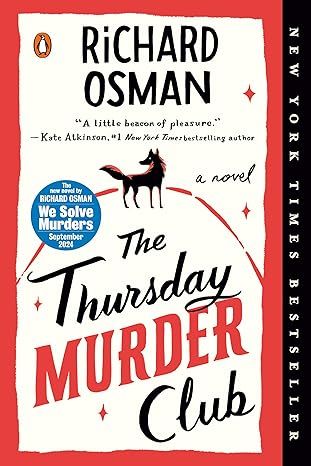
The Thursday Murder Club: A Novel (A Thursday Murder Club Mystery)
4.3
-
155,575
$6.33

Sapiens: A Brief History of Humankind
4.6
-
140,302
$13.49

The Butterfly Garden (The Collector, 1)
4.3
-
88,556
$9.59
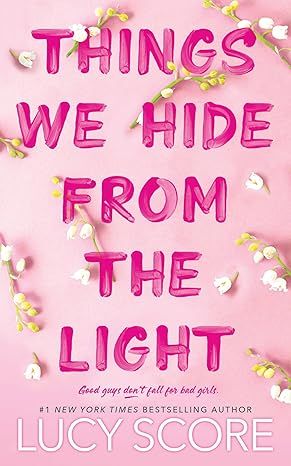
Things We Hide from the Light (Knockemout Series, 2)
4.4
-
94,890
$11.66
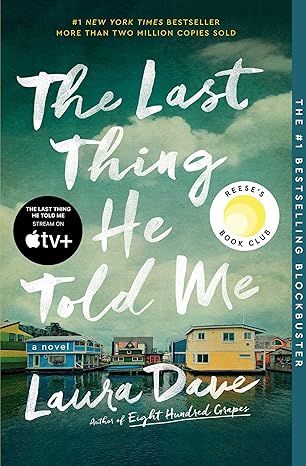
The Last Thing He Told Me: A Novel
4.3
-
154,085
$2.99
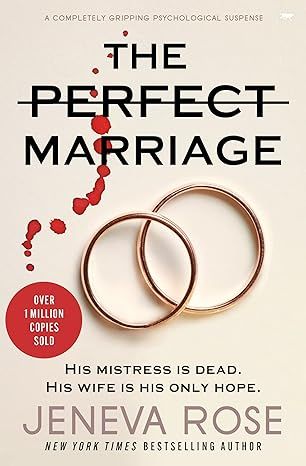
The Perfect Marriage: A Completely Gripping Psychological Suspense
4.3
-
143,196
$9.47

The Coworker
4.1
-
80,003
$13.48

First Lie Wins: A Novel (Random House Large Print)
4.3
-
54,062
$14.99
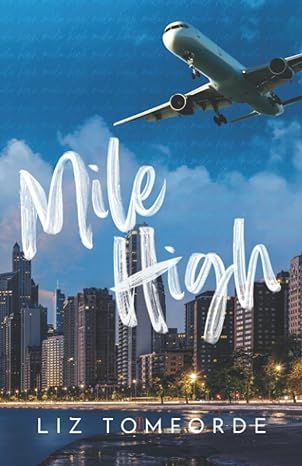
Mile High (Windy City Series Book 1)
4.4
-
59,745
$16.19

Layla
4.2
-
107,613
$8.99

The Locked Door
4.4
-
94,673
$8.53
